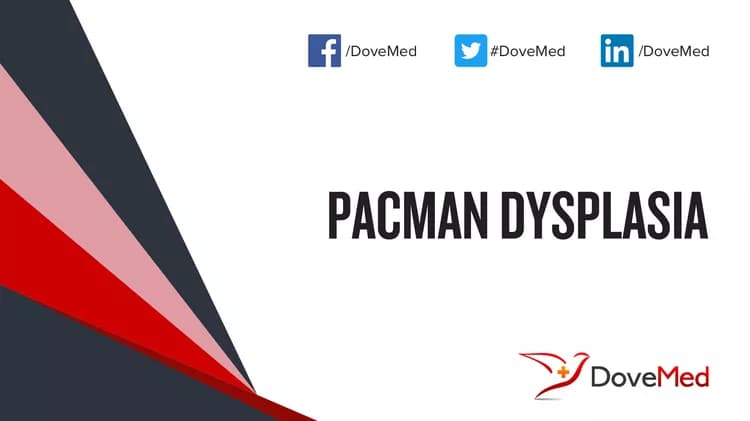What are the other Names for this Condition? (Also known as/Synonyms)
- Epiphyseal Stippling with Osteoclastic Hyperplasia
- Pacman Syndrome
What is Pacman Dysplasia? (Definition/Background Information)
- Pacman Dysplasia is characterized by epiphyseal stippling and osteoclastic over-activity
- It has been described in less than 10 patients but may be underdiagnosed. It is characterized radiographically by severe stippling of the lower spine and long bones, and periosteal cloaking. Patients also have short metacarpals
- The syndrome may be inherited as an autosomal recessive trait
- This disorder should be included in the differential diagnosis of mucolipidosis type II. In order to make a definitive diagnosis, lysosomal storage should be investigated by electron microscopy, or enzyme assays should be performed
- Familial recurrence can be easily detected by prenatal ultrasonography. This skeletal dysplasia is lethal
(Source: Pacman Dysplasia; Orphanet, National Institute of Health and Medical Research (INSERM), Paris.)
Who gets Pacman Dysplasia? (Age and Sex Distribution)
- Pacman Dysplasia is a very rare congenital disorder, described in fewer than 10 individuals in the medical literature
- The presentation of symptoms may occur before or at birth
- Both males and females may be affected
- Worldwide, individuals of all racial and ethnic groups may be affected
What are the Risk Factors for Pacman Dysplasia? (Predisposing Factors)
- A positive family history may be an important risk factor, since Pacman Dysplasia can be inherited
- Currently, no other risk factors have been clearly identified for Pacman Dysplasia
It is important to note that having a risk factor does not mean that one will get the condition. A risk factor increases one’s chances of getting a condition compared to an individual without the risk factors. Some risk factors are more important than others.
Also, not having a risk factor does not mean that an individual will not get the condition. It is always important to discuss the effect of risk factors with your healthcare provider.
What are the Causes of Pacman Dysplasia? (Etiology)
- The gene mutation that causes Pacman Dysplasia is not known at the present time
- The condition is inherited in an autosomal recessive manner
Autosomal recessive inheritance: Autosomal recessive conditions are traits or disorders that occur when two copies of an abnormal gene have been inherited on a non-sex chromosome. If both parents have an autosomal recessive condition, there is a 100% likelihood of passing on the mutated genes to their children. If, however, only one mutant copy of the gene is inherited, the individual will be a carrier of the condition, but will not be present with any symptoms. Children born to two carriers, have a 25% chance of being homozygous dominant (unaffected), a 50% chance of being heterozygous (carrier), and a 25% chance of being homozygous recessive (affected).
What are the Signs and Symptoms of Pacman Dysplasia?
The signs and symptoms of Pacman Dysplasia may include:
- Abnormality of metabolism/homeostasis
- Bowing of the long bones
Based on the frequency of symptoms observed, the following information may be noted:
Very frequently present symptoms in 80-99% of the cases:
- Abnormality of calvarial morphology
- Coronal cleft vertebrae
- Epiphyseal stippling
- Genu varum
- Hypotelorism
- Patent ductus arteriosus
- Rough bone trabeculation
(Source: Pacman Dysplasia; Genetic and Rare Diseases Information Center (GARD) of National Center for Advancing Translational Sciences (NCATS), USA.)
How is Pacman Dysplasia Diagnosed?
Pacman Dysplasia is diagnosed on the basis of the following information:
- Complete physical examination
- Thorough medical history evaluation
- Assessment of signs and symptoms
- Laboratory tests
- Imaging studies
- Biopsy studies, if necessary
- Prenatal ultrasonography, since the symptoms may be apparent before birth
Many clinical conditions may have similar signs and symptoms. Your healthcare provider may perform additional tests to rule out other clinical conditions to arrive at a definitive diagnosis.
What are the possible Complications of Pacman Dysplasia?
The complications of Pacman Dysplasia may include:
- Complications due to impaired heart function
- Severe bone abnormalities which may cause fetal demise
Complications may occur with or without treatment, and in some cases, due to treatment also.
How is Pacman Dysplasia Treated?
There is no cure for Pacman Dysplasia, since it is a genetic condition. The treatment is usually given to manage the signs and symptoms and any complication that develops.
How can Pacman Dysplasia be Prevented?
Currently, Pacman Dysplasia may not be preventable, since it is a genetic disorder.
- If there is a family history of the condition, then genetic counseling will help assess risks, before planning for a child
- Active research is currently being performed to explore the possibilities for treatment and prevention of inherited and acquired genetic disorders
Regular medical screening at periodic intervals with tests and physical examinations are recommended.
What is the Prognosis of Pacman Dysplasia? (Outcomes/Resolutions)
- The prognosis of Pacman Dysplasia is poor, since the skeletal dysplasia in affected individuals is considered lethal
- Typically, the prognosis may be assessed on a case-by-case basis
Additional and Relevant Useful Information for Pacman Dysplasia:
The following DoveMed website link is a useful resource for additional information:
Related Articles
Test Your Knowledge
Asked by users
Related Centers
Related Specialties
Related Physicians
Related Procedures
Related Resources
Join DoveHubs
and connect with fellow professionals


0 Comments
Please log in to post a comment.